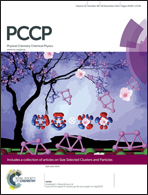Towards a high thermoelectric performance in rare-earth substituted SrTiO3: effects provided by strongly-reducing sintering conditions
Abstract
Donor-substituted strontium titanate ceramics demonstrate one of the most promising performances among n-type oxide thermoelectrics. Here we report a marked improvement of the thermoelectric properties in rare-earth substituted titanates Sr0.9R0.1TiO3±δ (R = La, Ce, Pr, Nd, Sm, Gd, Dy, Y) to achieve maximal ZT values of as high as 0.42 at 1190 K < T < 1225 K, prepared via a conventional solid state route followed by sintering under strongly reducing conditions (10%H2–90%N2, 1773 K). As a result of complex defect chemistry, both electrical and thermal properties were found to be dependent on the nature of the rare-earth cation and exhibit an apparent correlation with the unit cell size. High power factors of 1350–1550 μW m−1 K−2 at 400–550 K were observed for R = Nd, Sm, Pr and Y, being among the largest reported so far for n-type conducting bulk-ceramic SrTiO3-based materials. Attractive ZT values at high temperatures arise primarily from low thermal conductivity, which, in turn, stem from effective phonon scattering in oxygen-deficient perovskite layers formed upon reduction. The results suggest that highly-reducing conditions are essential and should be employed, whenever possible, in other related micro/nanostructural engineering approaches to suppress the thermal conductivity in target titanate-based ceramics.


 Please wait while we load your content...
Please wait while we load your content...